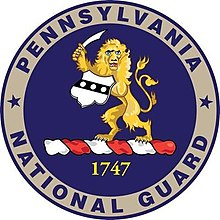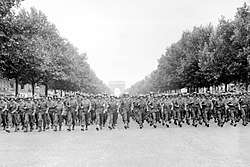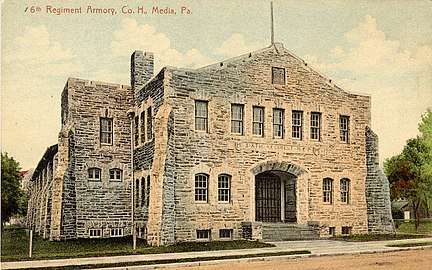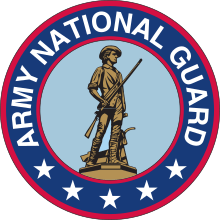Pennsylvania National Guard
The Pennsylvania National Guard is one of the oldest and largest National Guards in the United States Department of Defense. It traces its roots to 1747 when Benjamin Franklin established the Associators in Philadelphia.
| Pennsylvania National Guard | |
|---|---|
 | |
| Active | As militia: 1747-1870 As reserve: 1870-present |
| Country | United States |
| Branch | United States Army United States Air Force |
| Role | State Militia Reserve force |
| Size | Full Time: 3,500 Part Time: 15,500 |
| Garrison/HQ | Fort Indiantown Gap |
| Motto(s) | "Civilian in peace. Soldier in war." |
| Commanders | |
| Current commander | Major General Anthony Carrelli |
| Ceremonial chief | Governor Tom Wolf |
With more than 18,000 personnel, today the Pennsylvania National Guard is the second-largest of all the state National Guards. It has the second-largest Army National Guard and the fourth-largest Air National Guard.[1] These forces are respective components of the United States Army and Air Force.
The Pennsylvania National Guard is a component of the Pennsylvania Department of Military and Veterans Affairs, which is headed by Pennsylvania Adjutant General Maj. Gen. Anthony J. Carrelli and headquartered at Fort Indiantown Gap.
History
1700s
The Pennsylvania National Guard dates back to 1747 when Ben Franklin created the Associators in Philadelphia. Having overcome the long pacifist tradition of Pennsylvania's founding Quakers, Benjamin Franklin lead approximately 600 "gentlemen and merchants" of Philadelphia in signing the “Articles of Association” to provide for a common defense against Indian raiders and French privateers. These "Associators" (today's 111th Infantry Regiment and 103rd Brigade Engineer Battalion) are recognized as the foundation of the Pennsylvania National Guard. Within months, the Philadelphia Associators had brother units throughout the commonwealth.
In 1755, the Pennsylvania Assembly passed the first Militia Act, formally authorizing a volunteer militia.
In 1775, at the start of the American Revolutionary War, that The First Troop, Philadelphia City Cavalry (FTPCC) escorted General George Washington to New York to take command of the Continental Army. The Army's first units included a regiment of rifle companies from Pennsylvania.
During the American Revolution, Pennsylvania supplied 6,000 troops (4,500 of them Associators) for military operations in New York. One unit, the Philadelphia Artillery Battalion, lives on as today's 103rd Brigade Engineer Battalion. In all, tens of thousands of Pennsylvania soldiers were called to service over the next seven years.
After the American Revolution, the nation was put to the test when the militia in the Commonwealth of Pennsylvania was called upon to put down fellow citizens in the western part of the state during the Whiskey Rebellion. More than 4,000 militiamen from Pennsylvania served.
1800s
During the War of 1812, Pennsylvania forces again volunteered to defend the nation and the Commonwealth. Altogether, more than 14,000 Pennsylvanians actively served. During the Battle of Lake Erie, an artillery company provided volunteers to serve as cannoneers on Commodore Perry's fleet. That unit is known today as Wilkes-Barre's 109th Field Artillery Regiment.
During the Mexican War, Pennsylvania provided two regiments of volunteer militiamen from across the Commonwealth. Many of these companies that answered the call were already formed from existing regiments within Pennsylvania’s militia structure.
During the Civil War, after President Abraham Lincoln called for 75,000 volunteers to fight for the union, five units from the Lehigh Valley were quickly assembled and sent for protection. Lincoln called them “The First Defenders.” These guardsmen are the predecessors of today’s 213th Regional Support Group (RSG) based out of Allentown. More than 200 Pennsylvania Regiments took part in the American Civil War in 24 major campaigns.
On April 7, 1870, the term “militia” was replaced with the “National Guard of Pennsylvania."
In 1877, thousands of Pennsylvania Guardsman were called up to restore order during the Railroad Strike of 1877. The rioting was worst in Pittsburgh. Five Guardsman and 20 civilians were killed in the violence.
In 1898, the entire Pennsylvania division was mobilized and mustered into federal service at Mount Gretna for the Spanish-American War. Pennsylvania Guard units saw action in Puerto Rico and the Philippines.
1900s
In 1916, mobilization of the Commonwealth citizens occurred at Mt. Gretna for service on the Mexican Border. As troops began to come home, their mobilizations continued into the Great War, known today as World War I. The Pennsylvania division, now known as the 28th Division, was called up in the wake of America's entry into World War I. The division took part in six major campaigns in France and Belgium resulting in more than 14,000 battle casualties. With its entry into the war, the American forces helped turn the tide to the Allied victory. The 28th Division’s ferocity in combat earned it the title "Iron Division" from General John “Black Jack” Pershing, commander of the American Expeditionary Force.
In 1924, the 103rd Observation Squadron was organized at the Philadelphia Airport under the 28th Division. After World War II, the unit became the forerunner of today’s Pennsylvania Air National Guard.

By 1939, the world was once again at war. Ten months before the Attack on Pearl Harbor, the 28th Division was ordered into federal service. After America entered World War II, the division trained extensively, both in the homeland and abroad in England and Wales. Landing in France after D-Day, the division fought through Normandy, helped liberate Paris, and ended up bitterly engaged along the "West Wall" of Germany in November 1944. One month later, during the Battle of the Bulge, the division proved instrumental in stalling the last German offensive of the war. The German High Command nicknamed the division "Bloody Bucket" following the fierce battles of the Hurtgen Forest and the Bulge. The unit suffered more than 25,000 casualties of which 2,000 were killed in action. Elsewhere in the war, the division's 111th Regiment was detached to serve in the Pacific; Pennsylvania's 213th Regiment saw action in North Africa and Italy, while other units served across the globe.
In 1947, The Pennsylvania Air National Guard was formally established.
For its efforts during the Korean War, the 28th Infantry Division was mobilized to reinforce NATO forces and was sent to Germany. Several other Pennsylvania National Guard units saw active service in Korea.
On September 11, 1950, in route to Camp Atterbury, Indiana, the 109th Field Artillery was involved in a train wreck in which another train on the same track ran into the rear of the troop train, killing 33 service members from two different batteries. More than 1,000 National Guardsmen from various sections of the state, who had not been summoned for federal service, acted as a guard of honor for the bodies.
Pennsylvania Air National Guard airlift units flew 134 supply missions to Vietnam between during 1966-1967, becoming the first reserve air force to ever enter a combat zone without actually being mobilized.
In 1972, the worst natural disaster to-date struck the Commonwealth occurred, Tropical Storm Agnes. As a result of the extensive damage caused by storms and flooding, the Pennsylvania National Guard was engaged in relief operations. The storm hit June 21, 1972. Guard units began relief operations from June 22 through August 6, 1972. It affected 122 communities in 35 out of the 67 Pennsylvania counties, with the hardest hit area being the Wyoming Valley region (Wilkes-Barre in Luzerne County). More than 55,000 homes were completely destroyed, thousands of additional homes damaged, and 126 bridges destroyed. There were more than $35 million in crop damages, more than 200,000 telephones out of service, 49 deaths, and property damages well over $3 billion dollars. For the National Guard, a major call up was ordered. There were 12,036 Army National Guard and 644 Air National Guard members, for a total of 12,680 Pennsylvania National Guard personnel on duty during the flood.
During the invasion of Grenada the Pennsylvania Air Guard's 193d Special Operations Group (today’s 193d Special Operations Wing) provided airborne broadcasting and surveillance during the U.S. invasion. Later missions in Panama, Haiti and elsewhere earned the 193rd the distinction of being the most-deployed unit in the entire Air Force.
After the Iraqi invasion of Kuwait in August 1990, eight Army and Air Guard units from Pennsylvania[2] were mobilized for duty during Operations Desert Shield and Desert Storm. Among ANG units involved were the 193rd Special Operations Wing, flying C-130s modified to transmit radio and television signals, and the 171st Air Refueling Wing. Seemingly the four Army units were scheduled to all return home by May 1991.[3] Every member returned home safely.
Following the end of the Cold War, National Guard State Partnership Programs were established across Europe.The Pennsylvania–Lithuania National Guard Partnership was initiated in 1993 as part of a U.S. initiative to promote the growth of democratic institutions among the newly independent states of the former Soviet Union.
2000s
Approximately 1,100 28th Infantry Division Soldiers became the command element of NATO peacekeeping operations in Bosnia from 2002-2003.
28th Infantry Division units become the first Guard command element for peacekeeping operations in eastern Kosovo from 2003-2004. The 213th Area Support Group, Co. G, 104th Aviation and several smaller support units deployed in support of Operations Enduring and Iraqi Freedom.
Approximately 2,000 Pennsylvania Soldiers and Airmen were deployed in 2004 in support of Operation Iraqi Freedom to search for weapons of mass destruction, provide convoy security, rebuild infrastructure, and protect senior officials.
Approximately 750 Soldiers assigned to Task Force Dragoon helped to protect 29 polling locations during Iraq’s first free election in 2005. Task Force Dragoon units returned home in November. An additional 2,100 Soldiers from the 28th Infantry Division's 2d Brigade Combat Team, augmented by 2,000 Soldiers from 30 other states, touched down in Iraq in June. Known as the "Iron Brigade," Soldiers conducted convoy escorts and patrols, and provided training for Iraqi civil defense forces.
On September 1, 2005, Governor Edward G. Rendell mobilized 2,500 Pennsylvania Army and Air National Guard members to support hurricane disaster relief efforts along the Gulf Coast. Pennsylvania National Guard personnel arrived over the weekend of September 3-5. The relief mission lasted approximately 30 days.
2007 was a major year for the Pennsylvania National Guard. There were 380 Soldiers from 3d Battalion, 103d Armored Regiment that deployed to Afghanistan. At the same time, approximately 400 Soldiers of the 104th Cavalry departed for a deployment to the Sinai Peninsula. Members of these troops stood watch along the border between Egypt and Israel to ensure that the 1978 Camp David Accords peace agreement was upheld. Units from the 213th ADA Battalion, 131st Transportation Company, 104th Aviation, 228th Brigade Support Battalion, 107th Field Artillery, and 28th Division Support Command returned from their overseas deployments. Both Army and Air National Guard members deployed to the Mexican Border. Members of the 201st Red Horse Squadron (RHS) helped construct new roads and border wall sections.
In 2008, units from the 2nd Infantry Brigade, 28th Aviation Brigade, and 56th Stryker Brigade began training for overseas deployments. Units of the 55th Armored Brigade were currently overseas. Various Air Guard units including the 111th Fighter Wing, 171st Air Refueling Wing, and 193d Special Operations Wing conducted various support missions around the world.
In 2010 the governor of Pennsylvania mobilized members of the 193rd Special Operations Wing (SOW) to take part in a humanitarian assistance mission in Haiti, which was impacted by a major earthquake.
28th Infantry Division Song: "Roll On!"
By SGT Emil Raab (circa 1944)
We're the 28th men and we're out to fight again for the good old U.S.A.
We're the guys who know where to strike the blow and you'll know just why after we say:
Roll On, 28th, Roll On, set the pace, Hold the banners high and raise the cry , We're off to victory!
Let the Keystone shine right down the line for all the world to see.
When we meet the foe we'll let them know we're Iron Infantry,
So Roll On, 28th, Roll On!
Major Units
Army
28th Infantry Division (Harrisburg)
- 2nd Infantry Brigade Combat Team (Washington, Pa.)
- 28th Expeditionary Combat Aviation Brigade (Fort Indiantown Gap)
- 55th Maneuver Enhancement Brigade (Scranton)
- 56th Stryker Brigade Combat Team (Willow Grove)
213th Regional Support Group (Allentown)
Eastern Army National Guard Aviation Training Site (Fort Indiantown Gap)
166th Regiment Regional Training Institute (Fort Indiantown Gap)
Air
111th Attack Wing (Willow Grove)
171st Air Refueling Wing (Pittsburgh)
193rd Special Operations Wing (Middletown)
Leadership
The command element of the Pennsylvania National Guard is the Joint Staff.[4]
Commander-in-Chief: Governor Tom Wolf
The Adjutant General: - Major General Anthony Carrelli
Deputy Adjutant General - Army: Brigadier General Mark J. Schindler
Deputy Adjutant General - Air: Brigadier General Michael J. Regan, Jr
Gallery
 Media Armory
Media Armory- "PNG" inscribed at the Hamburg Armory
- Groff Armory in West Chester
.jpg) Armory in Nanticoke
Armory in Nanticoke
See also
- Associators
- Pennsylvania National Guard awards and decorations
- List of Pennsylvania state agencies
- Media Armory
- Pennsylvania State Guard
References
- "About the Pennsylvania National Guard". Pennsylvania DMVA. 2008. Archived from the original on 2007-10-31. Retrieved 2007-01-17.
- Historical Highlights of the Pennsylvania National Guard Archived 2014-01-06 at the Wayback Machine, accessed January 2014.
- Ron Devlin, State Guard Units Scheduled to Return Home by May, The Morning Call, April 21, 1991.
- "PA Army National Guard". Commonwealth of Pennsylvania. 2007. Retrieved 2007-01-17.

